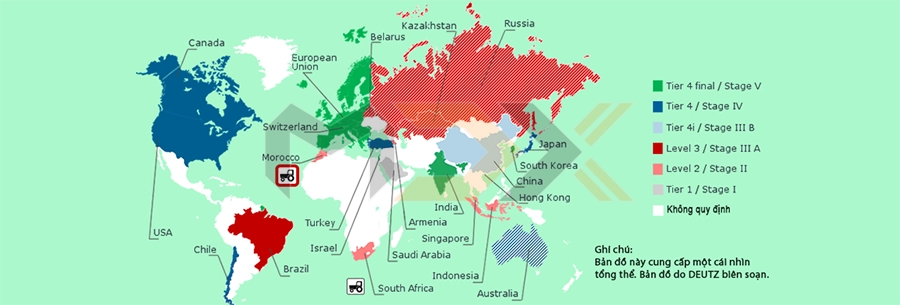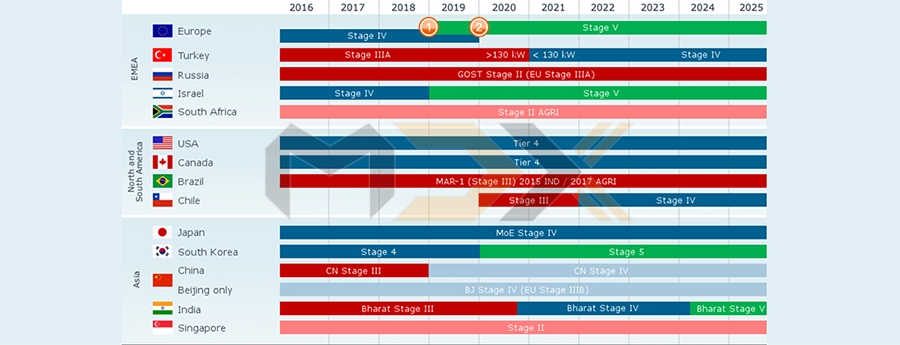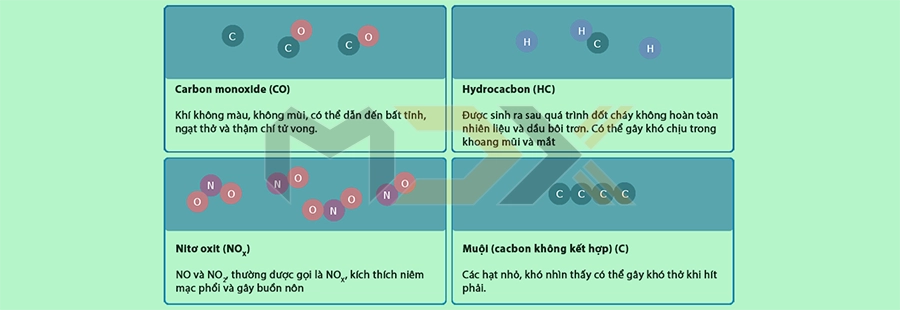EXHAUST EMISSIONS LEGISLATION AND ENGINE TECHNOLOGY (2019)
Legal and country-specific emissions standards apply to reduce the exhaust emissions of combustion engines in construction machinery.

INTRODUCTION

In Europe, the demands on the exhaust behaviour of mobile machines are determined by EU directives. The standards are applicable in all 28 member-states of the EU and the states forming part of the EFTA free trade zone (Iceland, Norway, Liechtenstein, Switzerland). European regulations are also recognised by other countries such as Turkey, Israel and Croatia, for example, and also apply in those countries. Exhaust emissions legislation in Europe, the USA and Japan is generally harmonised, i.e. the threshold values are similar. They do not apply to the required identification of combustion engines however!
WHAT EMISSIONS STANDARDS EXIST?

| Valid from | EU/EFTA | US EPA | Japan |
| 1999/1996 | Stage I | Tier 1 | Step 1 |
| 2001 | Stage II | Tier 2 | Step 2 |
| 2006 | Stage IIIA | Tier 3 | Step 3 |
| 2011 | Stage IIIB | Tier 4 interim | ––– |
| 2014 | Stage IV | Tier 4 | Step 4 |
| 2019 | Stage V | ––– | ––– |
THE BASICS OF EXHAUST EMISSIONS LEGISLATION

Many countries - mainly in Asia and Africa - have their own emissions standards based on prior European or US standards. The countries are designated in the following as LRCs (Less-regulated countries). However, some countries only recognise their own emissions standards or the UN ECE R24 or UN ECE R96 certificate.
Other countries have exhaust emissions standards on a level with EU Stage IV/EPA Tier 4. They are referred to in the following as HRC (highly-regulated countries).
With effect from 2020, India and China will be introducing their own emissions legislation based on the EU Stage IV / EPA Tier 4 standard.
Some countries have other regulations, such as fine dust and clean air standards, which apply in addition to their emissions legislation.
Abbreviations
- EPA - Environmental Protection Agency
- Tier - is used in combination with a number (Tier-1, Tier-2 or Tier I, Tier II, etc.) to divide a quantity into higher and lower priorities, where Tier 1 describes the highest priority.
OVERVIEW OF LEGISLATION FOR MOBILE MACHINERY 2019/20

SCOPE OF EU EMISSIONS LEGISLATION FROM 2019

SCOPE OF EPA EMISSIONS LEGISLATION

Special regulations apply to some European countries and overseas territories completely integrated into the national administrative structure. Special regulations should be clarified before accepting orders!
INTRODUCTION DATES OF THE NEW EU STAGE V THRESHOLD VALUES

The introduction of a threshold value limiting the number of particulates emitted requires installation of a diesel particulate filter (DPF) for engines with power outputs of 19 kW. The biggest technical changes (DPF) will occur in machines with engine power ranging from 19 to 56 kW. As on the introduction of previous new emissions standards, Stage V also allows for a transition period.
EMISSIONS LEGISLATION FOR MOBILE MACHINERY 2024

The introduction of Stage V in Europe will also see a change in global emissions legislation. Many countries are introducing more stringent threshold values
EXHAUST EMISSIONS LEGISLATION IN CHINA, INDIA AND BRAZIL

Note
- 1. 19 - 56 kW/ 130 - 560 kW from 2019
- 2: 56 - 130 kW from 2020
Differing designations
- China – CN (e.g. CN Stage III)
- India – Bharat (e.g. Bharat Stage III)
- Brazil – MAR-1 (e.g. MAR-1Stage III)
ENGINE TECHNOLOGY - INTRODUCTION

IN-ENGINE MEASURES TO REDUCE EMISSIONS
The exhaust emission threshold values in Stages I to IIIA/Tiers 1 to 3 are primarily achieved using internal engine measures:

INTERNAL ENGINE measures
- Development of high-pressure fuel injection (e.g. common rail)
- Electronic engine control systems
- Charge cooling system
- Uncooled exhaust gas recirculation
- Piston form
In order to comply with the EU Stage IV/EPA Tier 4 emissions regulations, exhaust aftertreatment is required in addition to in-engine measures.
INTERNAL ENGINE measures (cooled exhaust gas recirculation) + NON-ENGINE measures Exhaust aftertreatment, i.e. catalytic converter(s) and filters
EXHAUST EMISSIONS AND THEIR HARMFUL EFFECTS

EXHAUST CLEANING TECHNOLOGY – DOC

DOC – Diesel Oxidation Catalytic converter
The DOC has a catalytic surface which oxidises the carbon monoxides (COs) and uncombusted hydrocarbons (HCs) in diesel engine exhaust gases. In some operating states it also oxidises nitrogen oxides (NO) to produce nitrogen dioxides (NO2).
- Honeycomb substrate with a catalytic coating
- Reduces the gaseous pollutants CO and HC in a chemical reaction
- Oxidises NO (nitrogen oxide) to NO2 (nitrogen dioxide)
EXHAUST CLEANING TECHNOLOGY – DOC/DPF MODULE

DPF – Diesel particulate filter
A diesel particulate filter (DPF) is installed in the exhaust stream and fills with particles (PM) over time. As the filter only has a limited capacity, thermal regeneration (passive/active) occurs within the filter at a defined time, in which the particles are predominantly converted to carbon dioxide (CO2).
- Honeycombed structure with numerous channels, alternately closed at the ends. The particles are retained on the surfaces of the inlet channels.
- The DPF removes soot particles from the exhaust
- Highest efficiency in PM reduction (> 90 %)
EXHAUST CLEANING TECHNOLOGY – DIESEL PARTICULATE FILTER (DPF)

Advantages: Highest efficiency of PM reduction (> 90 %), suitable for applications complying with emissions standards such as TRGS 554, engines for internal use or Swiss VERT, continuous regeneration while the machine is running
Disadvantages: Maintenance required, service life > 3000h, diesel fuel with < 15ppm sulphur content required, "Park regeneration" rarely required
If the exhaust gas temperatures required for passive regeneration are not reached while the machine is in use, such as due to lengthy periods of idling, in rare cases so-called "park regeneration" must be carried out. To do this, the machine is parked in a safe location with its engine running and park regeneration is requested manually by pressing the necessary button. If the regeneration is not carried out when requested, or is aborted more than three times, the machine's diesel engine will run at reduced power and/or speed. For a detailed description of how to carry out park regeneration refer to the manual.
EXHAUST CLEANING TECHNOLOGY –SCR

SCR – Selective Catalytic Reduction
In selective catalytic reduction (SCR), the nitrogen oxides (NOX) in the exhaust gas are chemically reduced. To achieve this, an aqueous urea solution, e.g. AdBlue® solution, is added to the exhaust through an injector. The urea passively converts ammonia (NH3) and carbon dioxide (CO2) in the hydrolysis catalytic converter. Finally, the coating in the SCR catalytic converter facilitates the reaction of ammonia and nitrogen oxides to non-toxic nitrogen (N2) and water (H2O).
- Honeycomb substrate with a catalytic coating
- Highest efficiency in NOX reduction (up to 90 %)
- A 32.5 % aqueous urea solution (Urea/DEF/Adblue®) is used
EXHAUST AFTERTREATMENT TECHNOLOGY – DOC + SCR

Advantages:
- NOX reduction with highest efficiency (> 90%)
- "Open" flow system – no blocking, no ash cleaning
- Heat Management System (HMS) for smooth operation under all conditions
Disadvantages:
- Not suitable for applications complying with emissions directives such as TRGS 554, engines for internal use or Swiss VERT
- Maintenance regeneration required (1050 h after last successful regeneration)
- Additional urea required as operating resource
This exhaust aftertreatment is only used in conjunction with H 11i-12i.
EXHAUST AFTERTREATMENT TECHNOLOGY – DOC/DPF + SCR

Advantages:
- PM reduction with highest efficiency (> 90 %)
- NOX reduction with highest efficiency (> 90%)
- Suitable for applications complying with emissions standards
- HMS for smooth operation under all conditions
Disadvantages:
- Abnormal operating conditions may require park regeneration
- Maintenance regeneration required (550 h after last successful regeneration)
- Additional urea required as operating resource
OPERATING RESOURCES
INTRODUTION

Diesel, oils and urea solution
Now that we have looked at exhaust emissions legislation and the related engine technologies, we will study the operating fluids for engines with exhaust aftertreatment.
- Ultra-low sulphur diesel
- Low-ash engine oils
- Urea solution
- (DEF – Diesel exhaust fluid)
DIESEL

The use of ultra-low sulphur diesel is absolutely necessary. The sulphur content of this fuel is max. 15 mg/kg or 15 ppm. Using non-standard diesel fuel will result in damage to the exhaust aftertreatment system and the diesel engine. Availability of ultra-low sulphur diesel in Germany is already taken for granted, but it is not yet fully available across all EU countries. In Germany there is no special construction plant diesel, but only one type of diesel for all vehicles. In some EU countries this is different.
ENGINE OILS

Requirements on engine oil specifications are also increasing. Low-ash engine oils are specified. Sulphate and oxide ashes, phosphor, sulphur and sulphur compounds have a negative impact on catalytic converter activity in aftertreatment systems (e.g. SCR) and significantly shorten the service life of diesel particulate filters. Consequently, the oil industry has developed low-SAPS (low Sulphated Ash, Phosphorous and Sulphur) oils. Advantages:
- Protects the exhaust aftertreatment systems
- Protects against engine deposits
- Reduces wear during cold starts
UREA SOLUTION

A urea solution is required to utilise SCR technology. This urea solution is already used in numerous vehicles and is widespread within the EU and making further advances in the USA. Its trade names include AdBlue®, Blue Sky, Greenox, Air1, DEF, for example. The urea solution is non-toxic, non-hazardous and colourless. However, the urea solution has particular properties that must be observed:
- Its freezing point is -11°C, so it needs to be heated.
- An expiry date of 6 months is only possible if stored below 35 °C; decomposition begins at 50 °C.
- Corrosive; pH value is 9-10 (alkaline)
What is DEF?
AdBlue® is the brand name for DEF, a limpid, synthetically produced, 32.5% solution of high-purity urea in demineralised water. It is non-toxic, odourless and available in Europe, North America (under the designation DEF = diesel exhaust fluid) and many other countries. AdBlue® is non-flammable and does not require any special safety precautions. Depending on driving style, AdBlue® consumption is generally 3–4% of the fuel consumption of a Euro IV engine.
Storage conditions
AdBlue® freezes at temperatures below -11 °C. However, it can be liquefied again by warming and be used without loss of quality. At temperatures higher than 25 °C, AdBlue® decomposes rapidly; it decomposes completely at temperatures above 60 °C. Its shelf life is at least 12 months at storage temperatures not greater than 25 °C.
Benefits of AdBlue®:
- No influence on servicing and oil replacement intervals
- Reduction in nitrogen oxide emissions by up to 90 %
- Reduction in carbon dioxide emissions by up to 7%
Disadvantages of AdBlue®:
- Additional space required for the DEF tank
- Usability and storage duration dependent on temperature
- Heating of DEF tank and lines
- Additional effort due to AdBlue® filling and storage
- Maintenance interval 550 h (park regeneration)


